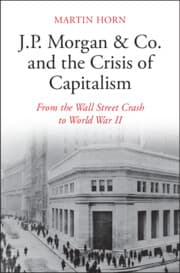
Book Review
J. P. Morgan & Co. and the Crisis of Capitalism: From the Wall Street Crash to World War II, 2022
By Martin Horn
Martin Horn set out to achieve two goals and he succeeded: to write the history of the firm J.P. Morgan & Co from 1929 to 1940 and to integrate it with the history of capitalism during the same period. He finds himself faced with the unenviable task of telling a story of an organization in decline, so there’s no rousing David and Goliath angle to it, no underdog who wins a battle, no hero who gets the prize at the end of the game. Instead, it’s the story of a company who simply managed to survive.
The firm survived because it reluctantly pivoted from its old, successful business practices to new ones in the face of two shocks to capitalism: the Crash of 1929 and the Great Depression. Intended to find the causes of the Crash of 1929, the Pecora US Senate investigation ended with the passage of the Glass Steagall Banking Act in 1933, a statutory shock that would cleave the Morgan firm in two. The high-margin investment banking business moved to a new firm, Morgan Stanley, in 1935. The low-margin commercial banking business remained as J.P. Morgan & Co. The shock of the Great Depression made it difficult for the commercial banking arm to build its business. The partners could not depend on their old network of contacts nor on their own expertise in raising investment capital to translate immediately into success at the stodgier commercial lending trade. In the face of risks from deepening depression, the partners often chose to maintain high levels of cash, rather than risk making loans to unsuitable borrowers. Reflecting these circumstances, partnership equity in the firm declined from $30 million in 1935 (after the Morgan Stanley exodus), to only $19 million at the end of 1939. Finally, with the payouts of capital due to the deaths of some partners, the firm decided to incorporate and issue shares in 1940 rather than keep its original partnership organization. Selling shares in the bank would be a way for the remaining partners to rebuild the capital base.
Horn tells the story in eight chapters. Chapters One and Two are background about how the firm hit its zenith in influence by the late 1920s. Chapters Three through Five cover the twin shocks to capitalism, with some focus on the three 1931 crises in the early phase of the Great Depression: Creditanstalt, turmoil in Germany, and of course, the British sterling crisis. Horn recounts how the Morgan partners believed at first that if Europe could just recover from WWI, their firm would get back on track. The partners did not expect a second war. Chapters Six through Eight show how and why the partners’ minds and strategies changed, and how the firm tried unsuccessfully to shape New Deal fiscal and monetary policy. The Chapters are flanked with a 10-page Introduction that lays out Horn’s research questions and a 7-page Conclusion in which Horn writes that it was the firm’s commitment to American capitalism that explained its survival through the 1930s.
The author uses expansive archives, weaving memos, letters, memoirs, newspapers and government reports together to tell the story. The curse of so much available material is that it can be hard to knit it together to develop a coherent theme. Horn skilfully follows a rational trail through this mass of documentation. Historians searching for an engaging writing style would do well to focus on pp. 96-105. The archives behind these pages are memo responses from the Morgan partners to questions from the press, customers, or other partners so the reader can sense a question/response rhythm to the narrative. Because many of the memos are written notes of conversations AMONG partners as they debated issues, one gets the feeling for what the actual conversation sounded like at the proverbial water cooler. Horn selects photographs to match his active writing style. While many photos are partners’ passive portraits or posed lineups of partners at events, several photos place the reader “in the room” at the Pecora hearings, for example, amplifying the conversational, fly-on-the-wall feeling of the book (222).
In addition to general historians who might benefit by studying Horn’s technique of narrative development, other researchers will also likely enjoy this book. Economists who study banking and the Federal Reserve will appreciate the chronicling of conversations between Morgan partners and politicians as debates arose for how to get the economy growing again after the shock of the Great Depression. Business historians who study how firms respond to shocks will appreciate this case study of how a firm that loses its high-margin, high-risk line of business adapts to managing its residual low-margin, low-risk line of business. The non-academic audience may appreciate knowing the history of one of today’s leading global banks.
In summary, Horn tackles what might be the hardest decade of the history of the House of Morgan to research, the decade of 1930s decline. It would be another 50 years after Horn’s study ends before the firm would regain its earlier pre-eminence as the leader of American capitalism, but without surviving the treacherous decade of the 1930s, the revival would not have been possible. In 1987 Vincent Carosso wrote the history of the firm’s rise to its pre-WWI peak in The Morgans: Private International Bankers 1854-1913. In 1990 Ronald Chernow devoted the second half of his 800-page The House of Morgan: An American Banking Dynasty and the Rise of Modern Finance to the revival of Morgan & Co. from WWII to recent times. Horn courageously works in the dispiriting middle years between the stories Carosso and Chernow tell and fills an important gap in our understanding of how the partners pivoted, when necessary, in order to live to fight another day.
Mary Tone Rodgers
State University of New York at Oswego